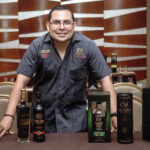The Evolution of Rum: Reflections of a Legend, Don Pancho
Don Pancho, whose real name is Francisco José Fernández Pérez, is a legendary figure in the rum industry with more than 50 years dedicated to learning, researching, developing, and producing rum. He was born in Cuba, where he also learned the tradition of the Cuban style of rum from his mentor, Ramón Fernández Corrales. Graduated as a biochemist and microbiologist, Don Pancho was a pioneer in rum research and development at a time when the title of “Master Blender” did not yet exist.
Don Pancho has had a distinguished career, initially in Cuba, where he worked for 40 years for Havana Club, one of the most recognized rum brands worldwide. Subsequently, he moved his experience and passion for rum to Panama, where he played a crucial role in the success of Ron Abuelo and led the rejuvenation of the Las Cabras distillery. His vision and experience have significantly contributed to establishing Panama as a leading player in the rum industry globally.
In addition to his work with Ron Abuelo, Don Pancho is known for his line of Orígenes rums, which includes expressions of 8, 18, and 30 years old, all of which are examples of excellence in rum production and highly appreciated by rum connoisseurs.
Don Pancho’s contribution to the rum industry is immeasurable, having dedicated his life to perfecting the art of producing high-quality rum and teaching future generations the value of tradition and innovation in rum making. His legacy includes not only the exceptional rums he has created but also his influence on the rum industry globally.
History and rationale
Don Pancho, with his retrospective gaze and accumulated wisdom, transports us to the birth of the rum industry, a time when sugarcane alchemy began to weave its legacy into the culture of the Caribbean and beyond. For him, rum is not simply a product; it is the “joyful son of sugar cane,” a spirit that encapsulates the essence of its plant origin and the lands that nourish it. This vision is based on the belief that wherever sugarcane flourishes, there is the potential to create rum, thus underscoring the universality and adaptability of this distillate.
The rum industry, as Don Pancho describes it, is as much a reflection of geographical diversity as it is of human ingenuity. As he narrates his story, he highlights how Caribbean countries, such as Venezuela, Colombia, Panama, and Guatemala, have become synonymous with quality rum, each bringing its own unique touch to the global rum landscape. But his analysis does not stop there; it extends to less traditional regions such as Spain, specifically the Canary Islands, and even Asia, illustrating how rum production has been globalized, transcending the traditional borders of the Caribbean.
Don Pancho emphasizes the importance of sugarcane not only as a raw material but as the beating heart of the industry. It describes the process from the cultivation of cane to its transformation into molasses or cane juice, which are fundamental for the distillation of rum. This process, according to him, is an amalgam of tradition and technique, where soil quality, climate, and care in cultivation are as crucial as precision in fermentation and distillation.
Through his words, a deep appreciation for the nobility of the rum industry is revealed, underscoring that, although sugarcane does not require “great problems to control pests,” it does demand meticulous cultivation and a carefully orchestrated industrial process to transform this humble plant into a distillate of incomparable complexity and depth.
Don Pancho’s vision of the history and fundamentals of rum invites us to consider this liqueur not only as a drink but as a storyteller, a bridge between cultures, and a testament to the symbiotic relationship between man and nature. In his analysis, it is clear that rum is as diverse as the places where it is produced; each bottle is a world to discover, a universe of flavors waiting to be explored.
Passion for Quality: Aging and Production
At the heart of Don Pancho’s rum philosophy lies an unwavering passion for quality, which manifests itself at every stage of the production process, from the selection of sugarcane to the meticulous art of barrel aging. His narrative about this process not only reveals the technical secrets of distillation but also draws a clear line between authentic quality rums and those products of lesser lineage, the result of the mixture of alcohol, water, and flavorings.
The rum journey begins in the vast cane fields, where the quality of the raw material defines the potential of the final product. Don Pancho emphasizes the importance of grinding the cane to extract a rich and pure juice, which is then fermented and distilled, capturing the very essence of the plant. This transformation is not simply a chemical process but an alchemy that requires knowledge, patience, and, above all, respect for tradition.
The distillation, although guided by scientific principles, is elevated to art under the supervision of master rum makers such as Don Pancho. But it is in aging that rum truly takes on its character. Don Pancho describes how the use of American white oak barrels, previously used to age whiskey, imparts to rum its distinctive vanilla, caramel, and spice notes. This process not only enriches the taste of rum but also its complexity and smoothness, elements that are essential to classifying rum as superior quality.
The distinction between quality rums and the most basic blends is a topic that Don Pancho vehemently addresses. He criticizes the practice of some producers looking for shortcuts, mixing generic alcohol, water, and artificial flavors, and still labeling the result as rum. For him, these products not only lack the depth and richness of true rum but also detract from the tradition and art that define this noble drink.
Don Pancho maintains that a good rum is characterized not only by its carefully controlled fermentation and distillation process but also by patient and meticulous aging, which allows the liqueur to fully develop its aromatic and gustatory profile. This approach to production reflects a dedication not only to quality but also to respect for the consumer, offering a drink that is both a treat for the palate and a tribute to rum’s rich history.
Innovation and Tradition: The Necessary Balance
Don Pancho, with his vast experience and deep understanding of the rum industry, sees the evolution of this spirit drink not as a series of isolated changes but as a continuous dialogue between innovation and tradition. The introduction of white rums on the market, for example, represents for him a turning point that, although marked by commercial success, has posed challenges to the traditional perception of rum as a mainly aged distillate.
The appearance of white rums, Don Pancho clarifies, was in part a response to market demand for lighter and more versatile variants of rum, capable of competing in North America with popular national drinks and adapting to a wider range of cocktails. While this innovation opened up new commercial avenues and expanded the global reach of rum, it also sparked a debate about what constitutes “real” rum, especially among purists who value traditional aging methods.
For Don Pancho, the challenge is not to reject innovation but to maintain a balance that honors rum’s rich heritage while embracing the evolution of its forms and flavors. This balance is crucial to ensuring that, regardless of changes in consumption preferences or market trends, the essence of quality rum production remains intact. He stresses the importance of not losing sight of the industry’s “carte blanche”—the meticulous and patient aging process that gives rum its distinctive characteristics.
Adapting to changes, according to Don Pancho, does not mean compromising the quality or traditions that have defined rum for centuries. Rather, he sees innovation as an opportunity to enrich the tradition, introducing new fans to the world of rum while deepening appreciation among connoisseurs. The introduction of high-quality white rums, for example, can serve as a bridge for consumers to subsequently explore more complex and aged rums.
Don Pancho’s vision of innovation and tradition reflects a deep understanding that the future of the rum industry depends on his ability to honor his past while courageously adapting to the future. In his perspective, rum is not just a drink but a constantly evolving narrative, woven with threads of innovation and tradition, which together form the rich tapestry of its history and its future. This balance, he argues, is essential for rum to continue to thrive as a dynamic cultural expression and as a beverage appreciated globally for its quality and complexity.
Consumer Education and Evolution
In Don Pancho’s perspective, consumer education emerges as a fundamental pillar for the future of the rum industry. Through his years of experience, he has observed a significant shift in how consumers approach rum, moving from a focus on quantity to one on quality. This change not only reflects an evolution in consumption preferences but also highlights the importance of educating the public about the subtleties and richness of rum.
Don Pancho argues that educating consumers on how to appreciate rum is crucial to the development of the industry. Through education, consumers learn to distinguish between different types of rum, to understand the impact of aging on flavor, and to appreciate the complex notes that a good rum can offer.
The rum industry has responded to these changes in consumption preferences by adapting and evolving. Distilleries are investing more in educational programs, tastings, and tours that allow consumers to experience the rum production process firsthand.
The evolution of the consumer, from one who mainly valued price and accessibility to one who seeks quality and authenticity, has led the industry to focus on premium and artisanal rums. This trend towards the consumption of high-quality rums reflects a broader cultural shift towards mindful consumption and the pursuit of authentic and enriching experiences. Don Pancho sees in this evolution an opportunity for the rum industry not only to grow but also to deepen its cultural legacy, offering consumers not only a product but an experience that transcends the palate to touch the soul.
The Legacy and Future of Rum: Don Pancho’s Vision
Looking to the future of the rum industry, Don Pancho shares a vision enriched by decades of dedication and love for this spirit. In the twilight of an illustrious career, his gaze is projected forward, underscoring the vital importance of opening paths for the new generations—those passionate and creative young people who will take the rum legacy to new heights. For Don Pancho, the future of rum lies not only in the preservation of the traditions and methods that have defined the art for centuries but also in the innovation and freshness of perspectives that new talents can bring. This fusion of respect for the past with the audacity to explore new horizons is, in his opinion, the foundation on which the future of the industry will be built.
Don Pancho’s footprint in the rum industry is indelible, especially in Panama, where his work has been instrumental in raising the international profile of Panamanian rum. Through his tireless effort and dedication, he has helped position Panama on the world rum map, not only for the exceptional quality of its products but also for a production philosophy that harmonizes traditional craftsmanship with the highest quality standards.
Don Pancho sees his legacy not in awards or personal recognition, but in the lasting impact of his work on the rum industry and the drive he has given it to evolve while maintaining its essence. For him, the true tribute to his life dedicated to rum will be the continued flourishing of the industry, enriched by the contributions of new generations who have been inspired by his passion, knowledge, and commitment to excellence.
Conclusion
Reflecting on the profound teachings of Don Pancho, it is evident that his passion for rum transcends the mere production process to become a true cultural and artistic expression. His dedication to quality, innovation, and education has not only enriched the rum industry in Panama but has also left an indelible mark on the global stage. Don Pancho’s vision for the future, focused on the balance between tradition and innovation and the importance of educating new generations, serves as a beacon for those seeking to preserve and advance rum culture. His legacy is a powerful reminder that rum, more than a drink, is a living narrative of history, tradition, and community, inviting everyone to appreciate it not only for its taste but also for the art and passion that each bottle represents.
Source
Exclusive interview with Don Pancho for TheRumLab
About The Author
Journalist, Master's Degree in Management and Cultural Policies, Community Manager, Radio Host with a Diploma in Tourism Journalism. Product Manager at The Rum Lab.





